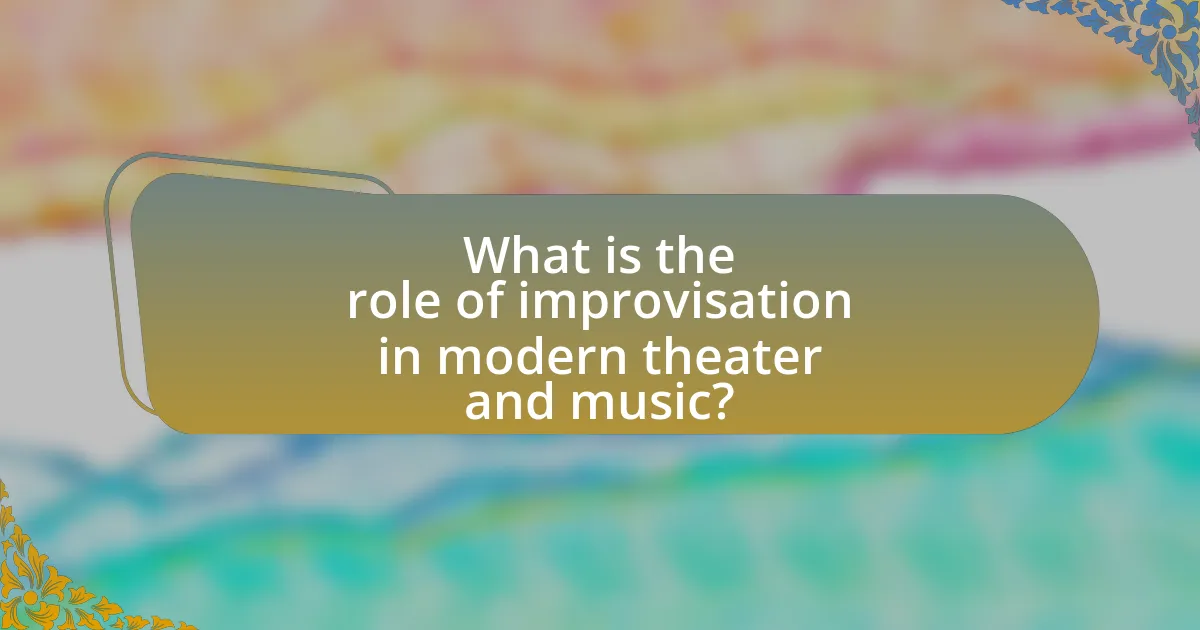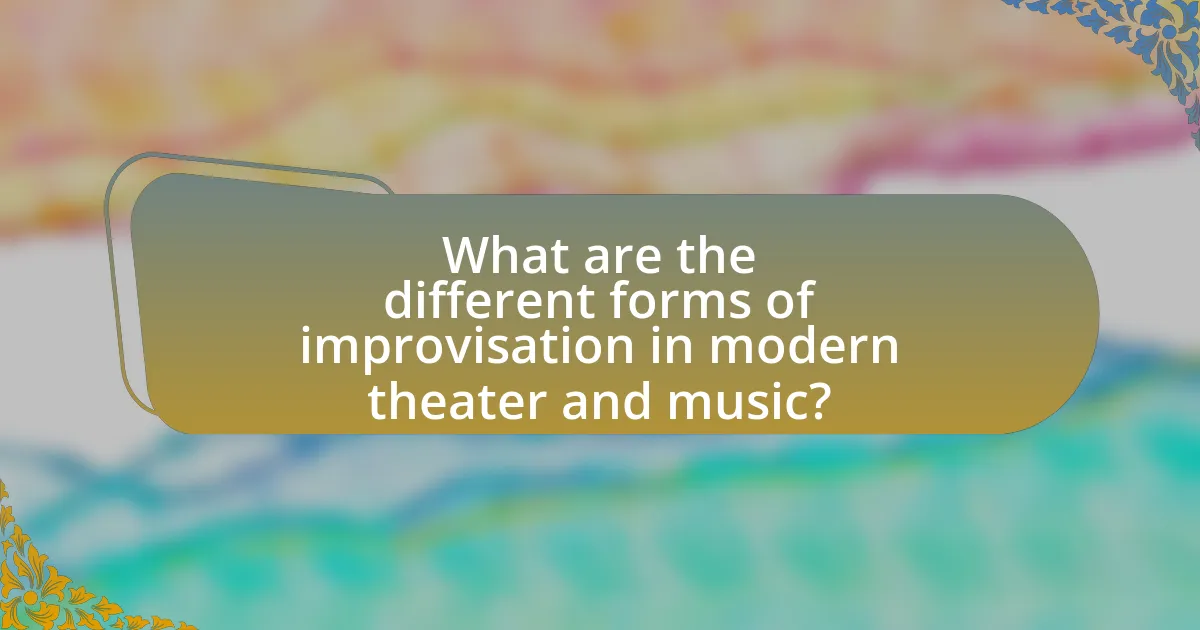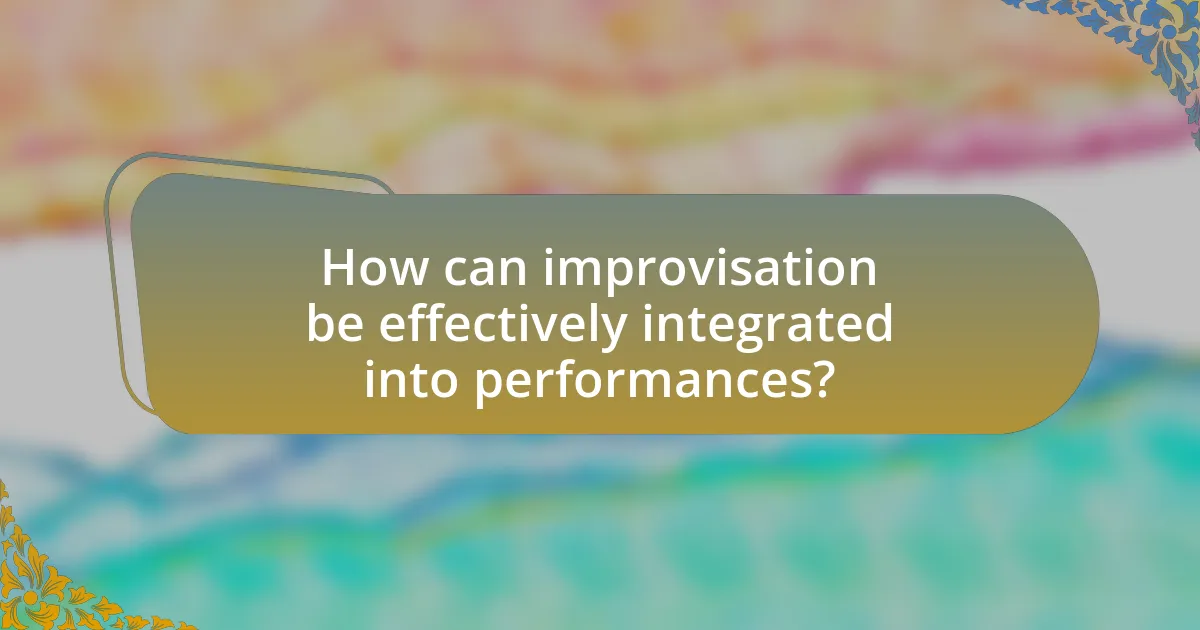The article examines the significant role of improvisation in modern theater and music, highlighting its impact on creativity, spontaneity, and audience engagement. It explores the evolution of improvisational techniques influenced by historical movements such as Commedia dell’arte and jazz, and discusses how cultural contexts shape improvisational practices. Key aspects include the development of essential skills in performers, the enhancement of audience interaction, and the various forms and techniques of improvisation utilized across genres. Additionally, the article addresses challenges faced by artists in improvisation and outlines best practices for successful implementation in performances.

What is the role of improvisation in modern theater and music?
Improvisation plays a crucial role in modern theater and music by fostering creativity and spontaneity in performances. In theater, it allows actors to explore characters and narratives in real-time, enhancing audience engagement and creating unique experiences. For instance, productions like “Whose Line Is It Anyway?” demonstrate how improvisation can lead to unexpected humor and dynamic storytelling. In music, improvisation enables musicians to express individuality and adapt to the energy of live performances, as seen in jazz, where artists like Miles Davis and John Coltrane often improvised solos that became iconic. This practice not only enriches the artistic expression but also cultivates a collaborative atmosphere among performers, making each performance distinct and memorable.
How has improvisation evolved in contemporary performances?
Improvisation in contemporary performances has evolved to become a central element that enhances creativity and audience engagement. In modern theater and music, artists increasingly incorporate spontaneous elements, allowing for real-time interaction and adaptation to audience reactions. This shift is evidenced by the rise of formats such as immersive theater and jazz performances, where performers often deviate from scripted material to create unique experiences. Research indicates that this evolution reflects broader cultural trends towards personalization and interactivity in the arts, as seen in the works of companies like Punchdrunk and musicians like Kamasi Washington, who emphasize improvisation as a means of storytelling and emotional connection.
What historical influences shaped modern improvisational techniques?
Modern improvisational techniques are shaped by historical influences such as the Commedia dell’arte, jazz music, and the avant-garde movements of the 20th century. Commedia dell’arte, originating in Italy during the 16th century, emphasized spontaneous performance and character-driven storytelling, laying foundational principles for improvisation in theater. Jazz, emerging in the early 20th century, introduced improvisation as a core element of musical expression, allowing musicians to create spontaneous melodies and harmonies, which influenced various genres. Additionally, avant-garde movements, including Dadaism and Surrealism, challenged traditional forms and encouraged artists to embrace spontaneity and unpredictability, further shaping contemporary improvisational practices in both theater and music.
How do cultural contexts affect improvisation in theater and music?
Cultural contexts significantly influence improvisation in theater and music by shaping the themes, styles, and techniques employed by artists. For instance, in jazz music, cultural backgrounds inform improvisational choices, as seen in the distinct styles of New Orleans jazz compared to Chicago jazz, reflecting regional histories and social dynamics. Similarly, in theater, cultural contexts dictate the narratives and character portrayals, as demonstrated by the use of traditional storytelling methods in African theater, which emphasizes communal experiences and oral traditions. These cultural elements not only guide the improvisational process but also enhance the authenticity and resonance of performances, making them relevant to specific audiences.
Why is improvisation important for artists in these fields?
Improvisation is important for artists in modern theater and music because it fosters creativity and adaptability. In theater, improvisation allows actors to respond spontaneously to unexpected situations, enhancing their performance and engagement with the audience. In music, improvisation enables musicians to explore new sounds and ideas, leading to innovative compositions and performances. Studies have shown that improvisational skills can improve overall artistic expression and collaboration, as seen in the work of artists like Keith Jarrett, whose improvisational concerts have garnered critical acclaim and demonstrated the power of spontaneous creativity.
What skills does improvisation develop in performers?
Improvisation develops several key skills in performers, including adaptability, creativity, and communication. Adaptability allows performers to respond effectively to unexpected situations, enhancing their ability to think on their feet. Creativity is fostered as performers explore new ideas and approaches spontaneously, leading to innovative expressions in their art. Communication skills are sharpened through the necessity of conveying ideas and emotions clearly and effectively in real-time interactions with other performers and the audience. Research indicates that these skills are crucial for success in dynamic performance environments, as they enable performers to engage more deeply with their craft and audience.
How does improvisation enhance audience engagement?
Improvisation enhances audience engagement by creating a dynamic and interactive experience that fosters a sense of connection between performers and spectators. This spontaneity allows performers to respond to audience reactions in real-time, making each performance unique and tailored to the specific audience present. Research indicates that audiences are more likely to feel involved and invested when they perceive a genuine interaction, as noted in studies on audience participation in live performances. For instance, a study published in the Journal of Applied Arts and Health highlights that improvisational techniques in theater can significantly increase audience emotional responses and overall satisfaction.

What are the different forms of improvisation in modern theater and music?
Different forms of improvisation in modern theater and music include spontaneous dialogue, musical improvisation, and physical improvisation. Spontaneous dialogue occurs when actors create dialogue on the spot, often seen in forms like improvisational theater or comedy. Musical improvisation involves musicians creating melodies or harmonies in real-time, a practice prevalent in genres such as jazz and blues. Physical improvisation focuses on movement and choreography, allowing performers to express emotions and narratives through unscripted physical actions. These forms highlight the dynamic and collaborative nature of modern performance, emphasizing creativity and adaptability in artistic expression.
How do different genres utilize improvisation?
Different genres utilize improvisation in distinct ways to enhance creativity and expressiveness. In jazz, musicians often engage in spontaneous soloing, allowing for personal expression and interaction with other players, which is a fundamental aspect of the genre’s performance style. In classical music, improvisation can be seen in the cadenzas of concertos, where soloists create unique passages that showcase their virtuosity and interpretative skills. In theater, improvisation is employed in forms like improvisational comedy, where actors create scenes and dialogue on the spot, relying on their instincts and audience interaction to drive the performance. Each genre’s approach to improvisation reflects its core principles, whether it be the collaborative nature of jazz, the structured freedom in classical music, or the spontaneous creativity in theater.
What are the key characteristics of improvisation in jazz music?
The key characteristics of improvisation in jazz music include spontaneity, creativity, and interaction among musicians. Spontaneity allows musicians to create music in real-time, often leading to unique performances that differ from one another. Creativity is essential as it enables artists to express their individuality and emotions through their instrument. Interaction among musicians fosters a collaborative environment where players respond to each other’s cues, enhancing the overall musical experience. These characteristics are foundational to jazz, as evidenced by the genre’s emphasis on personal expression and the dynamic interplay between performers, which has been documented in numerous studies on jazz performance practices.
How is improvisation applied in theatrical performances?
Improvisation is applied in theatrical performances as a technique that allows actors to create spontaneous dialogue and actions, enhancing the authenticity and dynamism of the performance. This method encourages performers to respond to each other and their environment in real-time, fostering a sense of collaboration and creativity. For instance, many modern theater companies incorporate improvisational exercises in rehearsals to develop characters and explore narrative possibilities, which can lead to unique interpretations of scripts. Additionally, renowned improvisational theater forms, such as “The Second City,” demonstrate how unscripted performances can engage audiences and create memorable experiences, showcasing the effectiveness of improvisation in enhancing theatrical artistry.
What techniques are commonly used in improvisational practices?
Common techniques used in improvisational practices include “Yes, and,” spontaneity, character development, and scene work. The “Yes, and” technique encourages acceptance and building on ideas presented by others, fostering collaboration and creativity. Spontaneity allows performers to react instinctively, enhancing authenticity in performances. Character development involves creating and embodying distinct personas, which enriches the narrative. Scene work focuses on establishing context and relationships, driving the story forward. These techniques are foundational in both theater and music, as they promote adaptability and innovation in performances.
What role does spontaneity play in improvisation?
Spontaneity is essential in improvisation as it allows performers to react instinctively to their environment and each other, fostering creativity and authenticity. This immediate response enhances the dynamic nature of performances, enabling artists to explore new ideas and directions in real-time. Research indicates that spontaneous actions in improvisation can lead to innovative outcomes, as seen in studies on jazz musicians who often rely on instinctual playing to create unique musical experiences.
How do collaboration and communication influence improvisational outcomes?
Collaboration and communication significantly enhance improvisational outcomes by fostering a shared understanding and synergy among participants. Effective collaboration allows individuals to build on each other’s ideas, leading to more innovative and cohesive performances. For instance, in jazz ensembles, musicians often rely on non-verbal cues and active listening to respond to one another, resulting in spontaneous and dynamic musical exchanges. Research by Sawyer (2006) in “Group Genius” highlights that collaborative improvisation can lead to higher creativity levels, as group interactions stimulate diverse perspectives and solutions. Thus, strong communication skills and collaborative efforts directly contribute to the richness and effectiveness of improvisational performances in modern theater and music.

How can improvisation be effectively integrated into performances?
Improvisation can be effectively integrated into performances by establishing a framework that encourages spontaneity while maintaining coherence. This can be achieved through techniques such as structured improvisation, where performers follow specific guidelines or prompts that allow for creative expression within a defined context. For example, in theater, actors can use improvisational exercises to develop character depth and enhance dialogue, as seen in the work of companies like The Second City, which emphasizes improvisation as a core component of their training and performances. Additionally, musicians can incorporate improvisation by using scales or chord progressions as a foundation for spontaneous solos, a practice rooted in jazz traditions, where artists like Miles Davis exemplified the power of improvisation to create dynamic and engaging performances.
What strategies can performers use to enhance their improvisational skills?
Performers can enhance their improvisational skills by practicing active listening, which allows them to respond effectively to their fellow performers. Active listening involves fully concentrating on what is being said, understanding the message, and responding thoughtfully, fostering a collaborative environment essential for improvisation. Additionally, engaging in exercises such as “Yes, and…” encourages performers to build on each other’s ideas, promoting creativity and spontaneity. Research indicates that improvisational training can improve cognitive flexibility and adaptability, skills crucial for effective performance in unpredictable situations. Furthermore, regular participation in improvisational workshops or classes can provide structured opportunities for practice and feedback, reinforcing these skills over time.
How can rehearsals incorporate improvisational elements?
Rehearsals can incorporate improvisational elements by allowing performers to explore spontaneous interactions and reactions within the framework of the script. This approach encourages actors and musicians to break away from rigid interpretations, fostering creativity and adaptability. For instance, incorporating exercises such as “improv games” or “free scene work” can enhance the performers’ ability to respond to unexpected situations, thereby enriching the overall performance. Research indicates that improvisation in rehearsals can lead to increased collaboration and innovation, as seen in studies by Keith Johnstone, who emphasizes the importance of spontaneity in theater.
What exercises can help develop improvisational techniques?
Exercises that can help develop improvisational techniques include “Yes, And” exercises, scene work with random prompts, and character development activities. “Yes, And” exercises encourage acceptance and building on ideas, fostering a collaborative environment essential for improvisation. Scene work with random prompts challenges participants to think quickly and adapt to unexpected situations, enhancing their spontaneity. Character development activities allow individuals to explore different personas, which can lead to more dynamic and varied performances. These exercises are widely used in improvisational theater training and have been shown to improve creativity and adaptability in performers.
What challenges do artists face when improvising?
Artists face several challenges when improvising, including the pressure to create spontaneously, the need for quick decision-making, and the risk of failure. This pressure can lead to anxiety, which may hinder creativity and performance quality. Quick decision-making requires artists to rely on their instincts and training, often in high-stakes environments where mistakes can be publicly visible. Additionally, the fear of failure can create a mental block, making it difficult for artists to express themselves freely. Research indicates that improvisation can enhance creativity but also poses risks, as highlighted in studies on performance anxiety and its impact on artistic expression.
How can performers overcome fear and anxiety related to improvisation?
Performers can overcome fear and anxiety related to improvisation by practicing mindfulness techniques and engaging in regular improvisational exercises. Mindfulness helps performers stay present and focused, reducing anxiety by promoting a non-judgmental awareness of their thoughts and feelings. Regular improvisational exercises, such as warm-up games and spontaneous scene work, build confidence and familiarity with the improvisational process, allowing performers to become more comfortable with uncertainty. Research indicates that consistent practice in improvisation can lead to improved performance skills and reduced anxiety levels, as demonstrated in studies on theater training and its psychological benefits.
What are common pitfalls in improvisational performances?
Common pitfalls in improvisational performances include lack of focus, failure to listen, and over-reliance on clichés. Lack of focus can lead performers to stray from the scene or narrative, diminishing the overall impact. Failure to listen to fellow performers disrupts the flow of interaction, resulting in disjointed performances. Over-reliance on clichés can make improvisation feel predictable and uninspired, reducing audience engagement. These pitfalls are frequently observed in both theater and music, where successful improvisation relies on collaboration and spontaneity.
What are the best practices for successful improvisation in theater and music?
Successful improvisation in theater and music relies on several best practices, including active listening, adaptability, and collaboration. Active listening allows performers to respond to each other in real-time, enhancing the spontaneity of the performance. Adaptability is crucial as it enables artists to adjust their actions based on the unfolding situation, ensuring a seamless flow. Collaboration fosters a supportive environment where performers build on each other’s ideas, creating a richer improvisational experience. These practices are supported by studies indicating that effective improvisation enhances creativity and group dynamics, as seen in research published in the Journal of Applied Psychology, which highlights the importance of teamwork in improvisational settings.
How can artists create a supportive environment for improvisation?
Artists can create a supportive environment for improvisation by fostering trust and open communication among participants. Establishing a safe space where individuals feel comfortable expressing themselves without fear of judgment encourages spontaneity and creativity. Research indicates that environments characterized by psychological safety lead to enhanced collaboration and innovation, as seen in studies by Amy Edmondson, which highlight the importance of trust in team dynamics. Additionally, incorporating structured exercises that promote active listening and responsiveness can further enhance the improvisational experience, allowing artists to build on each other’s ideas effectively.
What role does feedback play in improving improvisational skills?
Feedback is crucial in enhancing improvisational skills as it provides performers with insights into their strengths and areas for improvement. Constructive feedback allows individuals to reflect on their choices, adapt their techniques, and refine their responses in real-time scenarios. Research indicates that performers who actively seek and incorporate feedback demonstrate greater adaptability and creativity, leading to more effective improvisation. For instance, a study published in the Journal of Applied Psychology found that individuals who received specific feedback on their improvisational performances improved their overall effectiveness by 30% compared to those who did not receive feedback. This evidence underscores the importance of feedback in fostering growth and skill development in improvisational contexts.


